Building a butterfly garden should be on the list for every gardener. You can make your entire garden and landscape a butterfly garden or you can create a small, postage stamp garden specifically for butterflies. Anyone, even balcony gardeners can have a butterfly garden. You can have your own pollinator paradise in 9 easy steps.
I have created Monarch Waystations, butterfly gardens, and pollinator paradises for clients, friends, and myself over the years. One of my favorite creations was the Monarch Waystation at the Powhattan Fire Department in Powhattan, KS. Also, the circular butterfly garden I made in 2020 for Grimm’s Gardens is a favorite.
Step 1: Choose a Style for Your Butterfly Garden
As mentioned above, butterfly gardens come in all kinds of shapes. And styles. Even a meadow garden can be specifically for butterflies. The following list contains styles of butterfly gardens that you could choose from, though you might think of others.
- Monarch Waystation – this garden is specifically designed to help migrating Monarch butterflies by providing nectar and host plants for them. There are some rules to follow if you want to be certified at monarchwatch.org, but they are easy rules like having a certain number of milkweeds.
- Meadow Garden – a meadow garden designed for butterflies would be especially attractive to grass skippers and prairie butterfly species. These gardens are at least 60% native grass species, mixed with wildflowers.
- Pollinator Paradise – I gave this name to the garden that is rich in host and nectar plants, mostly native, which attract a large number of various pollinators, from butterflies and moths to bees and wasps.
- Pie Chart Garden – this is what I created in 2020 by the greenhouses here at Grimm’s Gardens. It is a circular garden, divided into 3 pie pieces, one for grasses, one for perennials, and one for annuals.
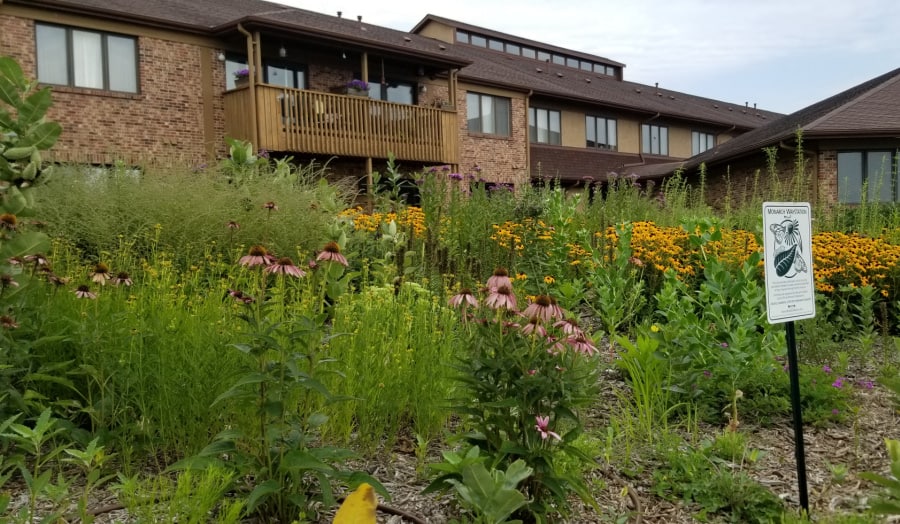
Step 2: Pick a Location for Your Butterfly Garden
Once you have a style of garden picked out, look for a suitable location for your garden to go. Many homeowners have at least a 10 foot square area somewhere on the property that would work. Bigger garden styles may be part sun and part shade. Follow these tips for choosing your butterfly garden location:
- Look for full sun. These are areas that receive at least 6 to 8 or more hours of bright, direct sunlight per day. This is the best location for butterfly garden plants. It can be in an open area, as long as there is no chance from chemical drift from crop ground.
- Part shade areas that receive 4 to 6 hours of sun per day. Most perennial and annual butterfly plants will grow here, but may be reduced in vigor and flower power.
- Well- drained soil, such as sandy clay loam, or loam is best for the plants. But many natives are tough enough to handle clay soils as long as it is situated where water will not sit.
- Rain garden areas such as where a sump pump drains or water sits after a rain are not ideal for butterfly gardens, but can become possible areas with proper plant selection.
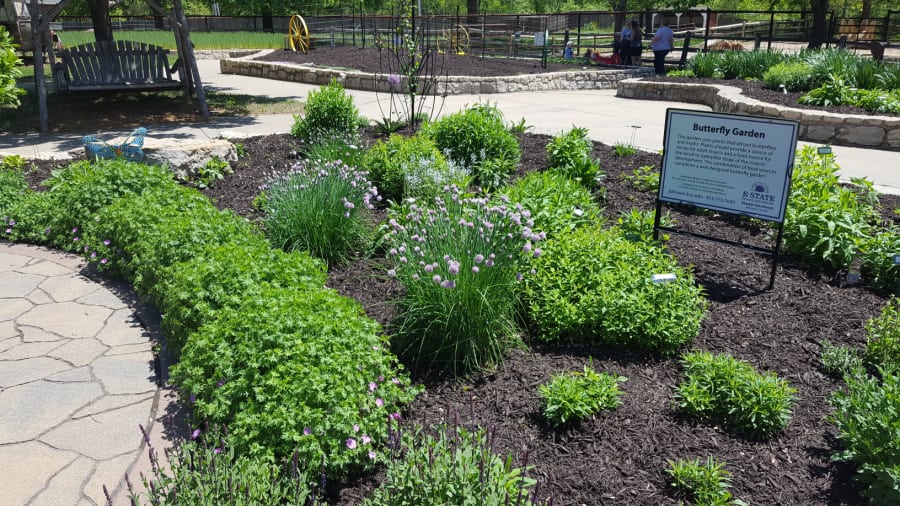
Step 3: Pick Plants for the Butterfly Garden
Normally I would not recommend buying or picking the plants until you have the bed prepared and ready, but you can have a list of plants to choose from for pre-ordering, or your future trip to the nursery. Also, it is good to know which plants you plan on having, before laying out a design on the ground.
Plants themselves should be free of diseases and weeds. If buying from the nursery, gently remove the plant from its container to check the roots. They should be white and smell of earth or soil, not brown and rotten smelling. Depending on the size of your butterfly garden, you may want to choose different plant sizes. Bareroot and container plants are best for small gardens; while plugs or bareroot plants are best for large gardens (over 250 square feet).
There are 2 types of plants you will need to focus on for attracting butterflies: nectar plants and host plants. Nectar plants are those which provide nectar for visiting butterflies and other pollinators. Host plants allow for the complete life cycle of the butterfly, where their eggs, caterpillars, and pupa can develop into adults. Be prepared for munching!
Host Plants for Butterflies
The focus here is on butterflies, not pollinators in general. Host plants are chosen specifically with a certain butterfly species in mind. Keep in mind though, that some butterflies are picky, and may never come to your garden plants. An example is the Regal Fritillary, which usually only lays eggs on prairie violets in prairie remnants.
I will lay out possible host plants per butterfly species, for those that use perennials and annuals. Butterflies that use tree species for host plants should already be present in the area.
- Silver Spotted Skipper – feeds on baptisia aka false indigo, American groundnut, and wild senna.
- Wild Indigo Duskywing – primarily uses false indigo.
- Common Checkered Skipper – uses members of the mallow family including purple poppy mallow, hollyhock, and hardy hibiscus.
- Delaware Skipper – feeds on native big bluestem and switchgrass.
- Dun Skipper – feeds on a variety of sedges including fox sedge, woodland sedge, and bottlebrush sedge.
- Black Swallowtail – feeds on members of carrot family including dill, fennel, wild carrot, Golden Alexanders, parsley, and chervil.
- Cloudless Sulphur – eats wild senna, partridge pea, and other legumes.
- Gray Hairstreak – feeds on many things including strawberry, sedum, purple poppy mallow, and prairie clovers.
- Summer Azure – feeds on New Jersey Tea.
- Monarch – all milkweeds, plus balloon plant (annual), and honeyvine milkweed (not a true milkweed).
- Gulf Fritillary – eats passion flower vine leaves.
- Variegated Fritillary – eats passion vine leaves, violets, pansies, and stonecrop sedum.
- Gorgone Checkerspot – feeds on sunflowers (annual and perennial), New England aster, and aromatic aster.
- Silvery Checkerspot – feeds on asters, sunflowers, rudbeckia, and coneflowers.
- Pearl Crescent – eats the leaves of asters and sunflowers.
- Common Buckeye – feeds on snapdragons, verbena, and plantains.
- Painted Lady – uses a variety of low plants including sunflowers, mints, Queen Anne’s lace, and more.
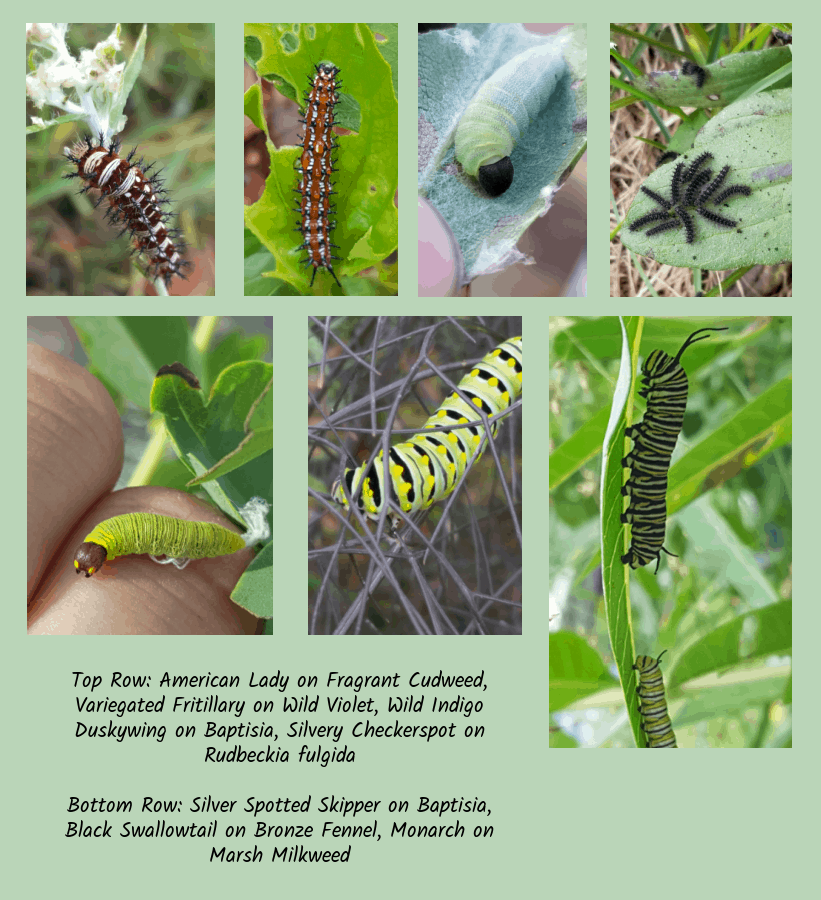
Nectar Plants for Butterflies
There can be a large number of plants that may attract various butterflies and other pollinators to your butterfly garden. However, we are focusing on perennials and annuals that would work best in the types of gardens listed above. These selections are based off my own interactions with butterflies in the gardens I manage.
Top 15 Perennials for Butterfly Gardens
- Coneflowers (Echinacea purpurea, Echinacea pallida, Echinacea angustifolia) and cultivars.
- Ornamental Onion ‘Millennium‘, ‘Serendipity’, ‘Mongolian Gem’
- Tall Sedum ‘Autumn Fire’, ‘Autumn Joy’, ‘Thundercloud’
- Asters (Aromatic, Hairy, New England, Willowleaf)
- Butterfly Milkweed
- Bonesets (Joe Pye Weed and others)
- Prairie Blazing Star
- Western Ironweed
- Woolly Verbena
- Garden Phlox
- Black Eyed Susans (R. hirta and R. fulgida)
- Swamp Milkweed
- Agastache cultivars
- Rattlesnake Master
- Veronica cultivars
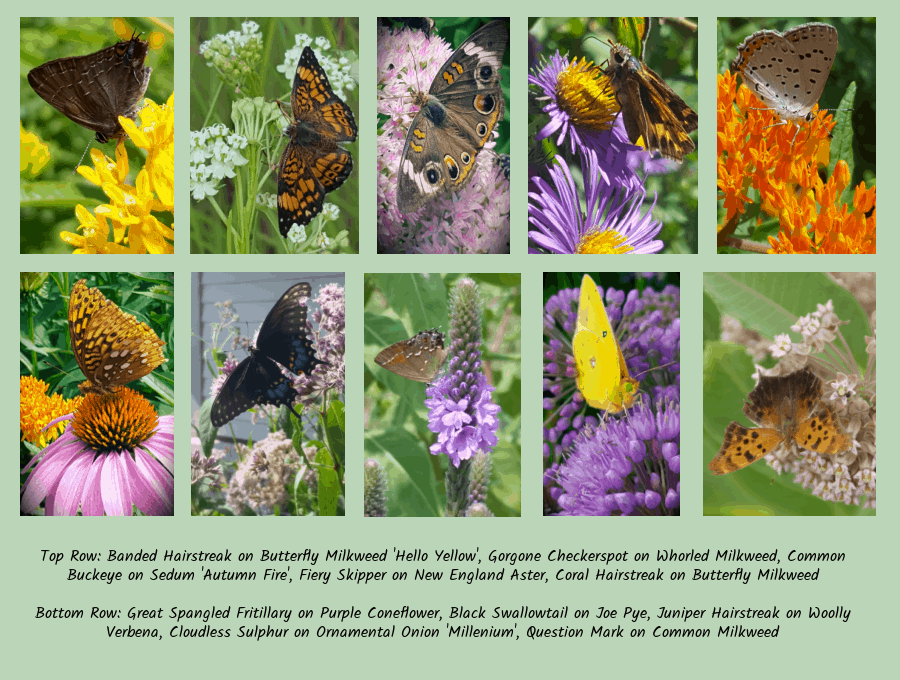
Additional Perennials to Attract Butterflies
- Butterfly Bush cultivars
- Goldenrod species and cultivars
- Mountain mints
- Salvia cultivars
- Coreopsis cultivars
- Blanket Flower
- Betony
- Blue Sage
- Baptisia cultivars
- Daisy cultivars
- Perennial Sunflowers
- Oxeye Sunflower
- Rose Verbena
- Beebalm cultivars
- Catmint cultivars
- Hardy Geranium
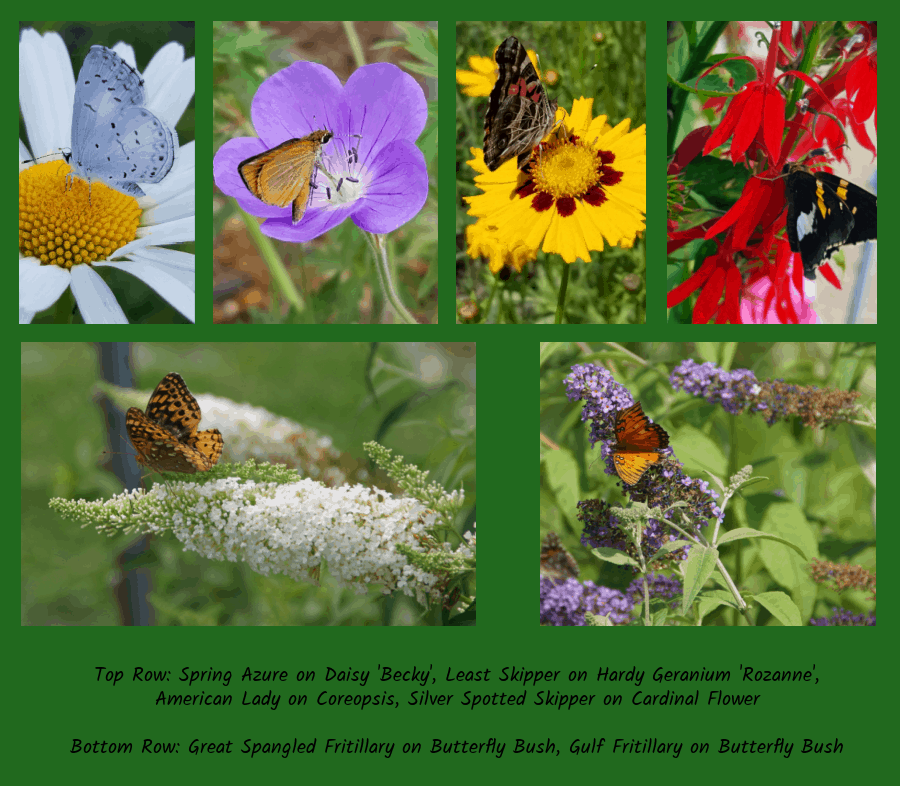
Top 5 Annuals for Butterfly Gardens
- Zinnias
- Mexican Sunflowers (Tithonia species)
- Brazilian Verbena
- Annual Salvias
- Helenium ‘Dakota Gold’
Step 4: Draw a Design or Layout the Bed on the Ground
While many gardeners like to have a drawing for their proposed gardens, many others just dig right in. I usually plan out the garden layout if doing a new bed for a client, but in my own garden I just dig right in. The following drawing is for the Grimm’s Gardens butterfly garden I designed, before prepping and planting.
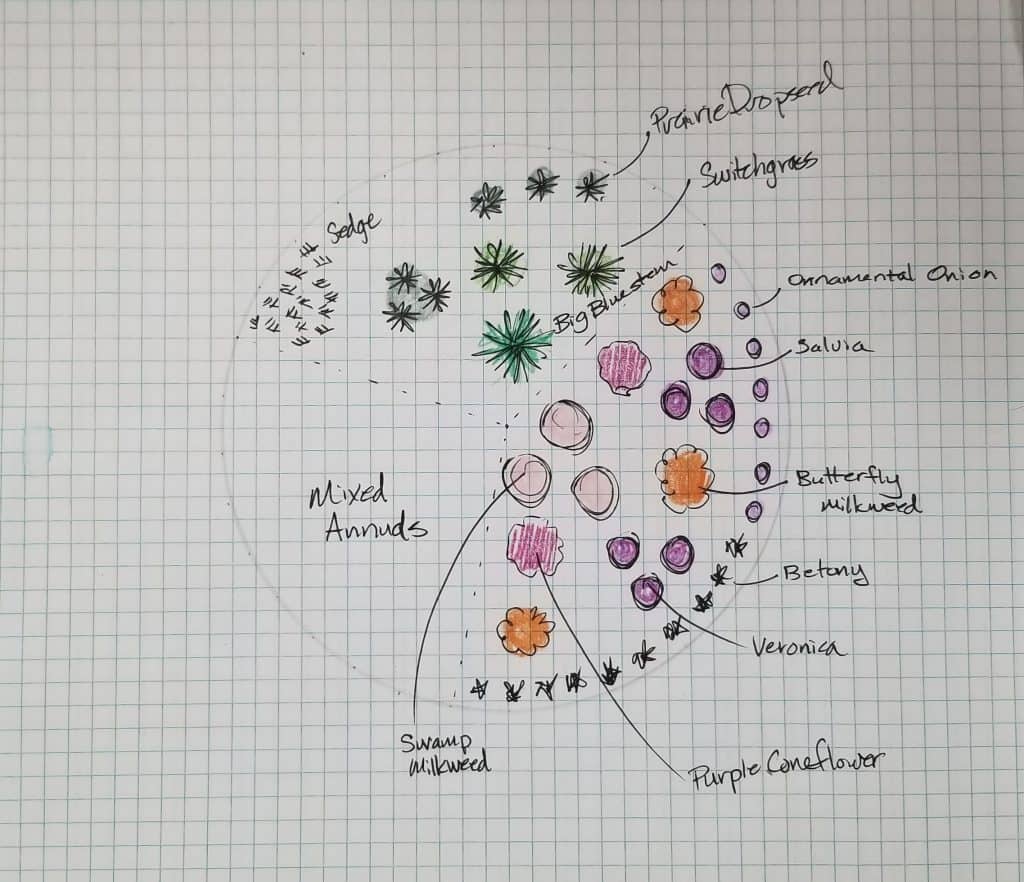
It may be easier to design with the use of labeled flags or stakes if you are working in your own space. Use stakes that are cut to size of the proposed plants and label them, then place them around the garden area until you are satisfied with the look. Leave the stakes in until planting.
Step 5: Prepare the Ground for the Butterfly Garden
Garden preparation can involve several steps within a step. But it does not have to be difficult. Rough out the shape of the bed (if not contained by walks or walls) with a used garden hose, twine, or paint.
I like to remove the sod from the area if it is less than 200 square feet (10 by 20). If it is going to be too much work to hand dig out the sod, you can rent a sod cutter, or plan to kill the grass with cardboard or a tarp. I do not recommend using a herbicide, unless your area is larger than 500 square feet.
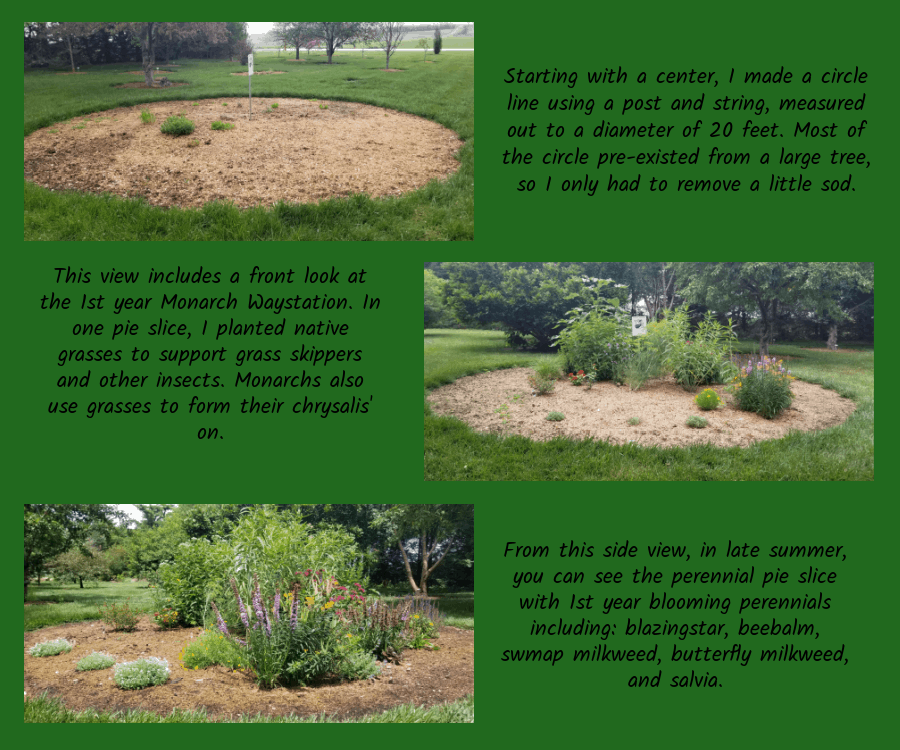
Once the grass is killed or removed, apply a layer of compost to 1-2 inches deep. If you are adding an edging material like steel, stone, or pavers, do that now.
If the soil is extremely dry, water the area for 2-3 hours, 24 hours before planting.
Step 6: Planting and Watering
Now that the bed for the butterfly garden is prepped and ready for plants, it is time for planting! The best time of the year to plant a new butterfly garden is about 2 to 3 weeks after your final frost in spring, or 2 to 3 weeks before your first frost in fall. Here in the Central Great Plains, that means around Mid-May in spring and Mid-September in fall.
Planting
If you used stakes to mark where each plant goes in your design, set your newly arrived or purchased plants by each corresponding stake. If you had a design pre-drawn, match the plants to the spots on the design, on the ground. Once each plant is where you want it to be, begin digging holes.
I like to plant one plant at a time, but you could dig all the holes, then do all the planting. Make the hole just big enough for the root ball of the plant, if using containerized plants. See diagram below for planting plugs, bareroot plants, and container plants.
Watering
Water each plant individually with a garden hose or watering can the first time, giving each plant double the amount of its container size. For example: a 1 gallon container should get 2 gallons of water the first time. Bareroot plants and plugs should each get just 1 quart of water the first time.
If your garden is small (under 250 square feet) you can water by hand with a hose or can. Water every day for 1 week, unless you get 1″ of rain per week. After the first watering, water the amount of the container size each week (a gallon for a gallon), and water bareroot plants and plugs 1 quart of water each time. After the first week of watering, water every 3rd day for 3 weeks, then water as needed through the rest of the year (any periods without 1″ of rain per 2 week span).
For larger gardens (over 250 square feet), it is be best to use a sprinkler system, set to water 1″ of water every week. Overhead sprinklers are the best for newly establishing butterfly gardens, as they deliver water not only to the plants, but to the surrounding soil. Keeping the whole soil mass moist keeps the soil from “pulling” the moisture from the plants through capillary action.
Step 7: Mulch Your Butterfly Garden
Newly planted gardens can lose soil moisture easily of there is no cover for the soil. However, you want to be wise when choosing a cover for the soil. I have found that weed barriers and rock are not good for butterfly gardens, becuase they prevent proper growth and spread of the plants and dirt and debris gets between the spaces of the rock, making a habitat for fast growing weeds.
Organic mulches such as chopped alfalfa, sawdust, or wood chips are best for covering the the soil. If using wood chips, steer away from dyed mulches and unknown chips from landfills or tree cutting companies as these may contain chopped pallets, or wood from trees with allelopathic chemicals such as oak, walnut, or Osage orange.
Chopped pine bark, cedar, or cypress mulch are the best wood mulches to use. Shredded and partially compost leaves, called leaf mold, are also a good mulch. Cocoa hulls can be used if they are easy to get where you live, as long as you do not have dogs in your garden. Pine straw, which is more readily available in the Southeastern U.S., is also a good mulch.

Step 8: Adding in Extras
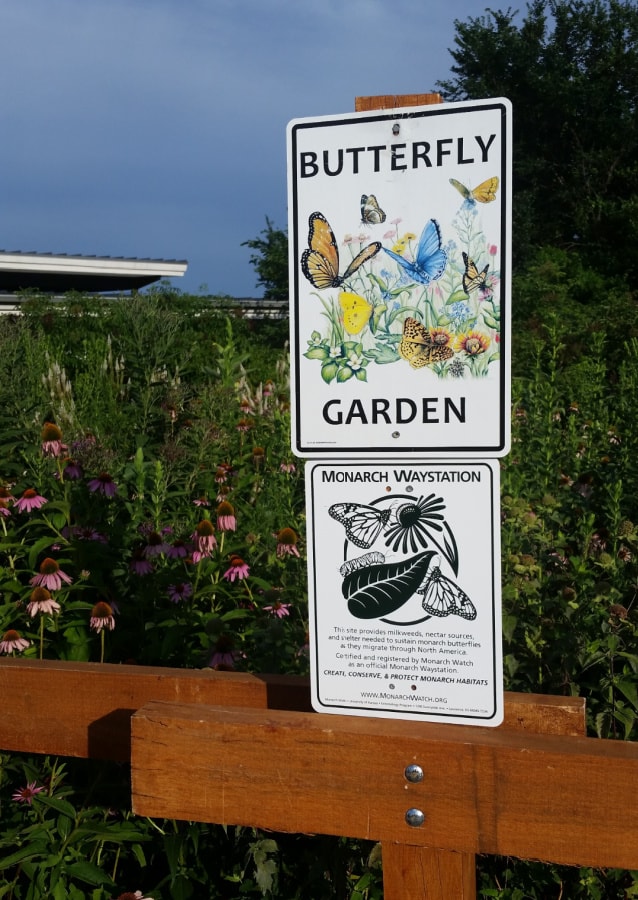
Butterfly gardens to some gardeners are not completed until you add things like butterfly houses or garden gnomes. You can add any of these things now. Butterfly houses may or may not work for the handful of overwintering adult butterflies, but you can always give it a try.
Other things to think about adding are a simple birdbath with perching stones placed in the water for landing. Many butterflies congregate around muddy spots or water, so giving them water is attractive. Change the water every 3rd day for best results.
Signage can also go up now if you have been certified as a Monarch Waystation or have a sign designating the spot as a Butterfly Habitat or Butterfly Garden.
Step 9: Enjoy!
This is always my favorite step, watching the plants grow and the butterflies landing on the flowers. I love seeing caterpillars eating leaves and watching all the other pollinators buzzing about the garden. Set up a lawn chair, make a glass of lemonade, sit back, and relax!
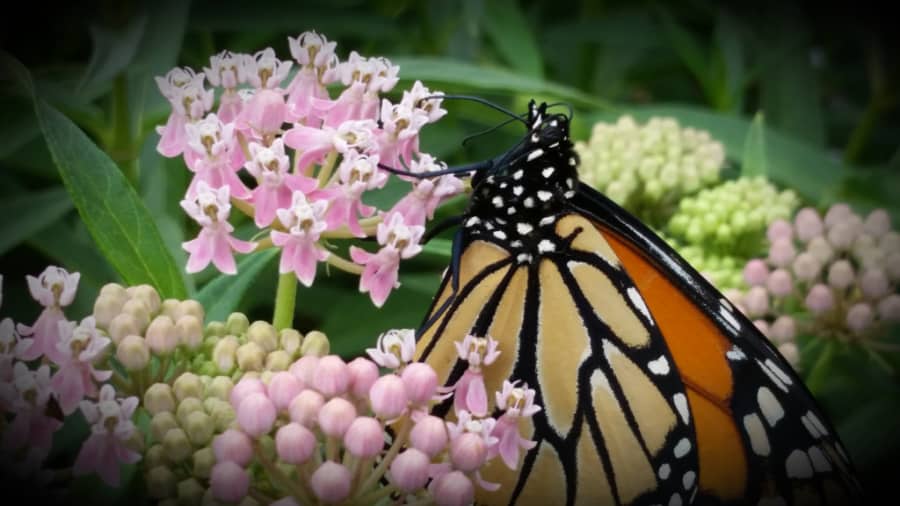
Conclusion
Building a butterfly garden is not just easy on paper, but easy in life too. Having designed, built and helped to build several for customers and friends over the years has made me realize just how rewarding and easy it is. Gardening becomes a part of your soul, as well it should.
Happy planting!
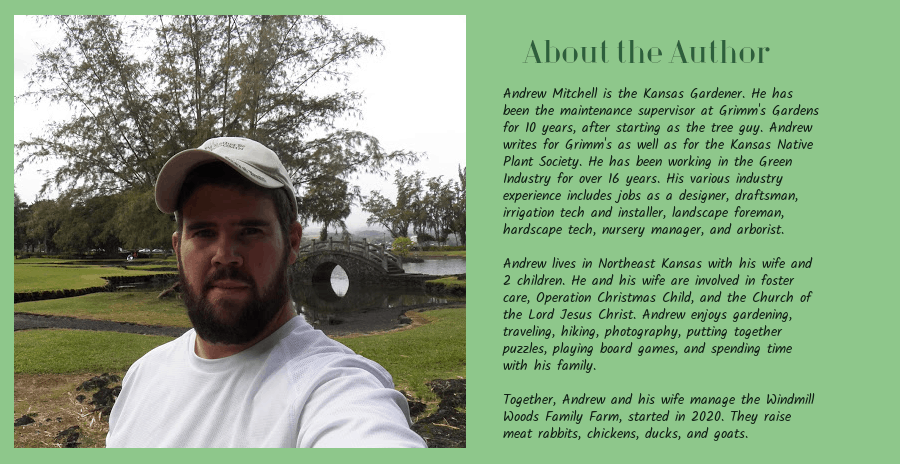
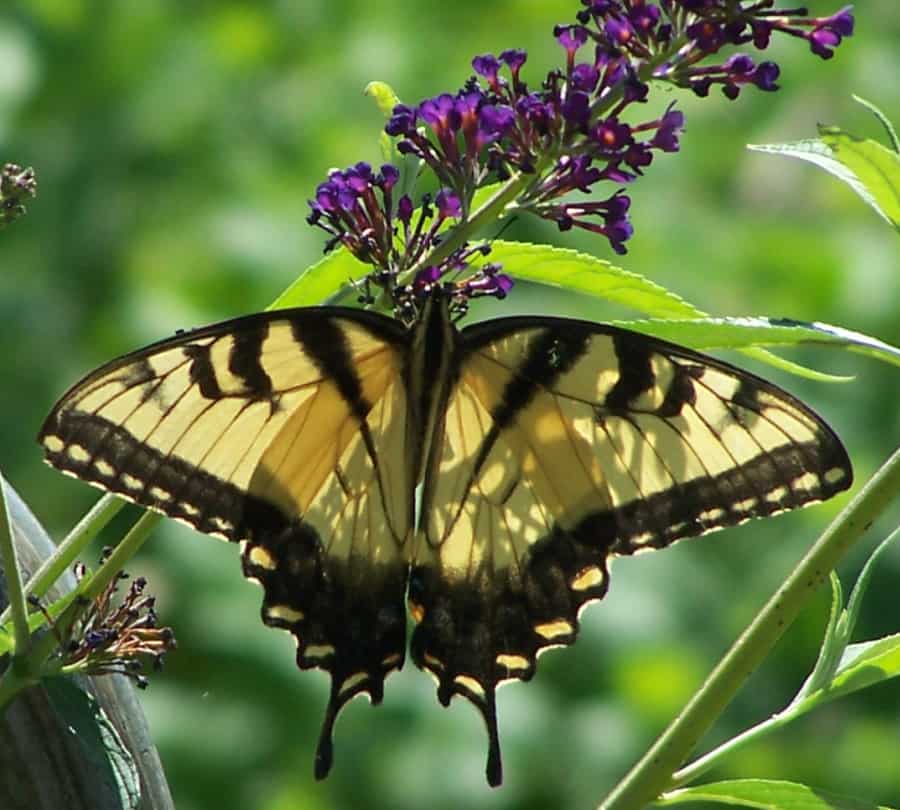



I am working on a pollinator garden & your article has been helpful! I‘ve read cedar mulch repels pollinators, butterflies, moths, insects in general. Wouldn’t that also include monarchs? Yet you mentioned using cedar mulch in your monarch gardens.
Hi Joan, thanks for reading and sharing! Yes, in the past I did use cedar mulch in the gardens. As a landscaper, our crews do still continue to use cedar in the garden, with no noticeable effects on butterfly, moth, or insect density. However, in my own home gardens, I use whatever organic material I can obtain, whether it is sawdust mulch, grass clippings from my never-sprayed lawn, or unsprayed animal bedding from our goats.
There is always a lot of discussion and research continually going on around each thing we use in the garden. I do use cedar mulch as pathway material, and have not noticed a drop in insect diversity in my gardens because of it. Because I use no pesticides, I have actually had an increase in insect diversity, so the mulch plays a very small if any role in deterring butterflies and moths.
Happy planting!
Andrew Mitchell